#immigrant social clubs
Photo

“Sault Moulds the Alien Into Good Canadian; Clubs, Lodges and Churches Help,” Sault Star. December 12, 1932. Page 3.
----
Italians Lead Numerically Those of Foreign Extraction; Finns Next
----
That the west end of the city is progressing from a social standpoint is amply demonstrated by a review of the various organizations existing in that section at the present time. Church, club and commercial enterprise have done a great deal in transforming he west end district from a sparsely settled shrub covered country of 20 years ago into the prospering, pleasant locality which it is today. With churches numbering in the neighborhood of 20, attended by residents of the west end to a great extent, clubs and lodges with an almost exclusive west end membership. numbering eight, not including those. with church connections and business establishments which compete with the average of any community, the residents of that part of the city are due to a great portion of the credit for the making of a thriving and friendly Sault Ste. Marle
Unlike the eastern part of the city, the west end is divided to a great extent into small communities, each populated by people of a certain nationlity. The new Canadians, consisting of people of Italian, Polish, Ukrainian, Fincish, Ruthenian and Croatian stock, occupy the greater part of the section generally referred to as west. Each one of these small communities has its own churches, clubs and to some extent business establishments, but despite this fact the new Canadian resident cannot be termed clannish, for at all times he is willing to mingle and enjoy himself with the crowd.
There are several institutions which have done a great work in moulding the character of the people from the old land and their children, in such a manner as to render them first class Canadians, but probably the most outstanding of these are the All Peoples' United Church, the St. Mary's School and the McFadden School. In cases where the parents were poor and terribly busy in the grind and rush of earning a livelihood in a strange land, the three named institutions are deserving of every commendation for instructions and care rendered to the children along religious, social and physical lines.
The two leading Italian organizatlons are the Marconi and Sons of Italy Societies. The Marconi Society, which was established in the Sault in 1912, with only a few members, has now over 225 on the roll. Having been incorporated in 1917, it carries a sick relief fund, practically guaranteeing the members from financial distress on account of illness. The president of the Marconi Society is Mr. A. Candelori. The organization met for some time in the Sons of Italy headquarters, but last year built and opened their own hall on Albert Street West, on November 25. Their hall is located just opposite the St. Mary's School. The Sons of Italy, who for several years met in their hall en Queen Street, West, built a new hall on Cathcart Street which was opened September 21, of this year. The combined value of these two new buildings is estimated at about $30,000 and emphasises in a way the progress of the Italian people in the Sault. Mr. L. Pasquantonio Is the president of the Sons of Italy. There are sister lodges of these two organizations, the Princess Marie Jose Lodge of the Sons of Italy and the Electra Marconi Society, the ladies' lodge of the Marconi Society. There is also the Fratellanza Calabresía, a brotherhood society of the Italians. The Italians too. are artistic by nature and there are several musical groups, orchestras and bands, that give good entertainment. There is this year also a good dramatic club, that under the auspices of the Sons of Italy produces very creditable plays and concerts.
The Italians rank first as far as population is concerned among the New Canadian classes. There are 4,500 people in this city who are Italian by birth
Next to the Italians come the Finnish who in the past three or four years have come to the Sault in great numbers. The climate of the Sault is similar to that in Finland and the Finnish people favor the cold of the north country. Since 1928 the number has grown from nearly 1,000 to about 1,800. They are, to a considerable extent, the types that are known as seasonal workers, doing bush jobs in the winter and construction work in the summer. Owing to this fact the Finnish population of the Sault fluctuates with the seasons, there being twice as many here in the summer then there are in the winter. There are two distinct groups of Finnish people, the members of the Finnish Organizations, the official headquarters of which is on Thompson Street, and the Hussey Hall Group. They are ardent physical culturists, going in for wrestling and discus throwing a great deal.
Two nationalities that have close to the same population in the Sault, are the Ukrainians and the Croatians The Ukrainians number about 1,800. A great many of them reside in Bay View. They have two branches of their cultural organizations here, the Ukrainian Labor Farmer Temple and the Workers' Benevolent Society. Headquarters of both organizations are situated in Winnipeg. Two schools are maintained here, one in the city and one in Bay View, the purpose of which is to teach the children the language of their forefathers and to train them along musical lines. They have a keen sense of the artistic, and among them are some fine musicians. They have had a mandolin orchestra of 50 places, practically all children taking part. As these have grown older they have taken places in other orchestras. At the All Peoples' church there is a very good orchestra of Ukrainians, under the direction of Mr. D. Bondur. There is also an exceptional Croatlan orchestra under the direction of S. Bosnakovich, who is a composer as well as leader, and their music is full of lilting melody. The Ukrainians have the third largest language group in Canada, there being 300,000 in all from coast to coast. They come to a great extent from a state called Eastern Galicia, where land is scarce and the farmer (and Ukrainians are farmers by choice), has a hard time making his living.
The Croatians number about 100 families, and a population including single men, of about 1,500. They are not all west end residents. They have two local societies. the Croatian Fraternal Union and the Slavonian-Croatian Union.
The Poles and Russians in the city number less than is generally supposed, there being no more than 150 Poles and 100 Russians, though they have no classified organizations a number of them belong to the Ukrainian groups.
The Jewish group is the smallest yet most interesting body in the city. There are only 14 families, who have a 100 per cent organization in the Zionist Society, and who maintain a school to teach their children the Jewish language.
Other groups in the city of foreign stock are the Chinese, numbering 100, who have a society of 75 members known as the Kuo-min-tang, the Serbians numbering 100, the Czecho-Slovaks 150. Then there are several other nationalities represented by from 10 to 30 people. Among them are the Rumanian, the Bulgarian, German, Swede, Norwegian, Armenian, Syrian, Greek, Spaniard. Danes and White Russians, a nationality distinct from the Russian.
#sault ste. marie#immigration to canada#canadianization#immigrant canadians#immigrant social clubs#finnish immigration to canada#finnish canadians#italian canadians#italian immigration to canada#yugoslav immigration to canada#ukrainian canadians#ukrainian immigration to canada#chinese canadians#kuomintang#great depression in canada#northern ontario
3 notes
·
View notes
Text
Social Issues that Help with Understanding Buddy Daddies
Here are some political, social, and cultural aspects of Japanese culture that I think is important to keep in mind when watching Buddy Daddies. Please note: this is a super long post, with lots of pictures.
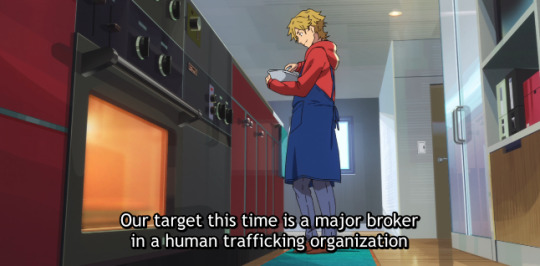

1. Human Trafficking - Slave Labor
In Episode One, we learn that Miri’s birth father was involved in labor based human trafficking involving Southeast Asian individuals. This is currently a very big issue in Japan, since Southeast Asian immigrants (among others) are viewed as a cheap labor option and usually experience slave labor like conditions.
From The United States Department of State website:
Men, women, and children from Northeast Asia, Southeast Asia, South Asia, Latin America, and Africa travel to Japan for employment or fraudulent marriage and are subjected to sex trafficking. Traffickers use fraudulent marriages between foreign women and Japanese men to facilitate the entry of women into Japan for sex trafficking in bars, clubs, brothels, and massage parlors. Traffickers keep victims in forced labor or commercial sex using debt-based coercion, threats of violence or deportation, blackmail, confiscation of passports and other documents, and other psychologically coercive methods.

2. Drugs in Japan
When I was living and working as an ALT in Japan, two ALTs (in a different district, but within the same company of my own), got caught with drugs. It was a big deal and ended up in the newspapers. The company I worked for had to do a lot of PR work with the elementary and junior high schools that they had contracts with, to ensure that the contracts would remain. As for me and the other ALTs? We had to sit through like five separate meetings within like two months about drugs and drug laws in Japan.
The barebones takeaway is that, in Japan, weed is viewed as being on the same level as hardcore drugs. Charges can be steep and strict. Even just knowing that someone has drugs, and you don’t say anything to law enforcement about it, can get you in trouble. There is a grey area with drugs, which is stuff like bath salts and the like. Since the selling of things like that cannot be prohibited, so they are easily accessible to the public.
Japan still has a very “90′s D.A.R.E.” approach to drugs. It’s catchphrase is 「ダメ。ゼッタイ。」or “No! Never.”

(Image from a Web Magazine called Nagasaki Press.)
When celebrities are caught with (what’s usually) weed, it can basically be the end of their careers, since recreational drug use of any kind (excluding alcohol, of course), is still negatively looked down upon in Japanese society. This is why it is still heavily left in the hands of the yakuza and drug kingpins, etc. Though there has been a recent increase in protests and ideology surrounding the idea of legalizing weed. Still, not much acceptance for recreational use is likely to come yet. However...
There may soon be some revision to the laws, which will allow for medical use:
Legislation changes scheduled for 2023
In 2021, the MHLW established an expert committee to review the Cannabis Control Act, and it is expected revisions will be proposed in a bill to be submitted in 2023. This will most likely allow for the use of medical cannabis. 2022/12/02
From: Euromonitor
So, something to keep in mind when Kazuki talks about a drug kingpin here is that this drug kingpin is likely not just dealing with super, hardcore drugs, but also softer ones too, like weed.

3. Child Protection Squad
There is this misconception in Japan that really young kids, like Miri’s age, can just roam free all around Japan and no one will find it odd. In Episode 1, we do see Miri roaming around the city without anyone really taking notice, but she also wasn’t in an area where there would be people that are trained to take notice.
In the above image she is at a park, which is likely close to a school somewhere. The man that approaches her here has a band around his jacket sleeve that says こども見守り隊 (kodomo mimamori-tai), which gets translated to “Child Protection Squad.” Basically, these are like crossing guards, in a way, because they do play a similar role to that, but they also do more than that as well:
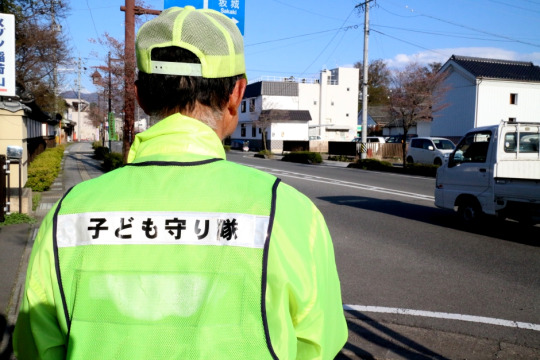
(Image from the Japanese website: Nice Senior).
This people basically ensure that kids stay on the right paths on their way to school. Most of the time, when elementary school children head off to school, they will go in groups (with the 5th or 6th graders being the leaders) and there will often be older people outside their houses on their way in, keeping an eye on the children to make sure they get to school okay.
And that’s talking about elementary school aged kids. For ones that are around Miri’s age, usually the parents (mostly mothers) will bring them by bike:
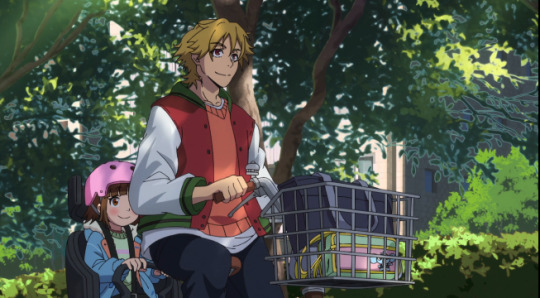
Or they will get picked up by a bus:

This one looks pretty boring in comparison to some others you might see though, like these:

(Image from the Hiyoshidai School Website)
Sometimes the daycare workers will also take them on little excursions outside using big strollers for the kids to travel around in:

(The image is obviously from a stock photo site called fotostock, but yeah, I’ve seen these before when I lived in Japan).
But a little toddler just sitting on her own at a mostly empty park with just a guy sitting at a park bench nearby watching her? That would raise attention and an eyebrow from someone who is essentially a crossing guard and whose job is to ensure the safety of kids as they travel to and from school.
The rest is under a Read More.

4. Police in Japan
I saw a comment somewhere (maybe it was over on Youtube) about how the cops are portrayed here in Buddy Daddies. The comment was basically that Japanese cops wouldn’t be that aggressive with a child. But, well, cops in Japan have issues like everywhere. Though, the main issue with cops recently has more so been with racial profiling:
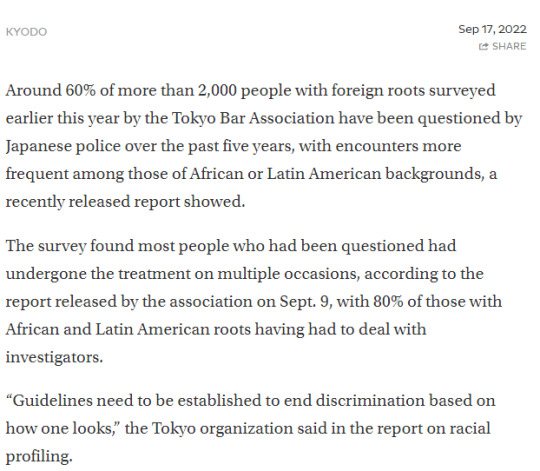
(Excerpt is from a Japan Times article entitled: 60% of people with foreign roots questioned by Japanese police, survey finds).
Of course, this situation is different from the one we see happening with Miri, but the Japanese police have issues with corruption too. So this happening wouldn’t seem too out of the realm of possibilities to me. The anime Tiger & Bunny 2 Part 2 also recently had some moments in the season where there was some anti-cop (ACAB-type) sentiments expressed by a character (though that series is also meant to take place in a city based on NYC).

5. Issues Surrounding Reproductive Rights, Contraception, and Abortion
“Took advantage of me” is fairly vague wording, but considering the type of guy he was, and the fact that Miri’s mother is caught in another abusive relationship, it wouldn’t surprise me if Miri’s conception wasn’t fully consensual one. People like to talk about how safe Japan is, but Japan has a lot of sexual violence that goes unreported:
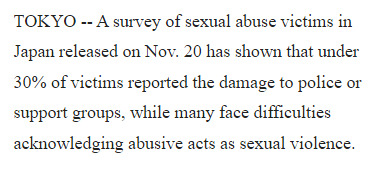
(From an article entitled: Many sexual violence victims in Japan do not report assaults to police, support groups: survey - The article was posted on November 24, 2020 over on The Mainichi news website).
There is a lot of societal pressure in Japan, that can cause a lot of judgement as well. Especially around issues of reproductive rights. From a Japan Times articles entitled: Pandemic provides an opportunity to improve access to contraception, posted on January 30th, 2022, we can get a little insight into the issues surrounding contraceptives:

The article also talked about the judgement that can come with contraceptives. The last line also talks about abortion, which comes with its own set of issues in Japan:

(From The Japan Times article: Abortion legal and apolitical in Japan, but cost and consent present barriers)
So abortion was likely an option that Miri’s mother didn’t think was really viable, especially in her situation.

7. Being a Single Mother in Japan, Adoption
In Ep.3 we hear Kazuki parroting a lot of the stuff you usually hear when it comes to women in children, like it is meant to be a natural and innate thing. There is a societal pressure for a woman to give birth and care for the child, even when they aren’t in the best situations to do so. Miri’s mother was, for all intents and purposes, a single mother. Since I doubt the abusive man she is currently with had any hand in helping Miri.
Being a single mother anywhere can be a big challenge, but especially so in Japan. Some issues that single mother’s face in Japan, according to the article “Why Most Families with Single Mothers in Japan are Living in Poverty” from a site called The Borgen Project:

From that same article, we learn that joint-custody and child support doesn’t exist in Japan. So Miri’s mother was likely under a lot of societal and financial stress, along with possible Post-Partum Depression, and (also probable) burnout. This doesn’t mean that her behavior or attitudes are okay, but that they are likely a result of a failed system.
I’ve seen some people bring up adoption, but adoption doesn’t automatically mean that a child will have a better life either. My grandfather’s mother was force to give her children up to the state, so my grandfather spent a good chunk of his life in an orphanage. It wasn’t a pleasant experience. And the probability that Miri would have been adopted had her mother gone through the actual system is, sadly, extremely low. From an article entitled: “The state of orphans in Japan and how to help” found on the site Zenbird.Media is this bit of information:

And even if Miri had been in an orphanage, Misaki (Miri’s mother) would still be her legal guardian.

So an option like that would be unappealing for Misaki, because she doesn’t want anything to do with Miri.

7. LGBT+ Individuals Being Viewed as “Not Productive”
Finally, we have the last thing I briefly want to talk about. The main backbone of Buddy Daddies, which is these two hitmen taking care of a child. Last year, a Japanese politician was in the news because she retracted some previous statements she made in 2016 and 2018. We are going to focus on her 2018 statements, which were:

Her comment received a lot of backlash and was big news. Her retracting her statements also brought a lot of news and talk too. The above information comes from The Japan Times article: “ Japanese lawmaker retracts past remarks on LGBTQ and other minorities.” Her other comments are awful too, but it should be noted that her one about sexual-minority couples stems from the issue of Japan’s declining birthrate. Even though many people in Japan are supportive of LGBT+ rights, there are people that hold a similar viewpoint as this.
Buddy Daddies is pretty directly challenging this ideology, especially with how they have been handling things. So that’s pretty cool and revolutionary in its own way. It makes me interested in seeing how this continued topic as well as any future social issue topics will be handled or touched upon in Buddy Daddies.
If you read this all until the end: thank you so much! I put a lot of work into this write up and I hope it can help (I learned some things too while researching!).
#Buddy Daddies#Kazuki Kusuru#Rei Suwa#Miri Unasaka#Misaki Unasaka#social issues in Japan#long post#meta post#image heavy post
4K notes
·
View notes
Text

MLK at 95.
January 15, 2024
ROBERT B. HUBBELL
Martin Luther King, Jr. was born 95 years ago on January 15, 1929. As a Baptist minister, he advocated non-violence while promoting civil rights. He spoke for the poor, the oppressed, and the disenfranchised. While he was imprisoned in a Birmingham jail for protesting segregation, he responded to eight white ministers who had criticized him for participating in protests that they described as “unwise and untimely.”
Dr. King’s famous reply to the white ministers explained why he traveled to Birmingham from Atlanta to protest:
I cannot sit idly by in Atlanta and not be concerned about what happens in Birmingham. Injustice anywhere is a threat to justice everywhere. We are caught in an inescapable network of mutuality, tied in a single garment of destiny. Whatever affects one directly affects all indirectly. Never again can we afford to live with the narrow, provincial outside agitator" idea. Anyone who lives inside the United States can never be considered an outsider.
While Dr. King was keenly aware of the racism that served as the understructure of the Christian church in the old South, he would be shocked by the virulent, mean-spirited, anti-Christian message that animates many (not all) evangelical congregations in America today. They form the backbone of Donald Trump's support in Iowa and beyond. They have adopted Trump's message that treats the poor, oppressed, and disenfranchised as “outsiders” and “others” who do not belong in America.
Over the last several days, we have learned that members of the Texas National Guard physically blocked federal Border Patrol agents from responding to reports of immigrants in distress in the Rio Grande. The bodies of a mother and two children were later recovered from the river in the area where immigrants were reported to be in distress.
Texas, of course, denies that its cruel actions caused the drownings—a denial that should be viewed skeptically from a state whose governor—Greg Abbott—recently commented Texas troopers could not shoot immigrants crossing the border because the troopers would be charged with murder by the Biden administration. Texas governor criticized after comment about shooting migrants | The Texas Tribune.
Similar animus underlies the recent comments of Mississippi Governor Tate Reeves, who withdrew Mississippi from a federal program to provide food to school children during summer breaks. Governor Reeves said Mississippi withdrew from the program to fight “attempts to expand the welfare state.”
Blocking efforts to rescue a drowning mother and her children? Regretting the inability to shoot immigrants because it would be murder? Denying food to poor children out of spite? Who are these people? How do they look at themselves in the mirror?
Ninety-five years after Dr. King’s birth and fifty-five years after his death, it is difficult to believe that people who identify as upstanding members of the Christian church can support such actions.
Another section from Dr. King’s Letter from a Birmingham Jail is relevant to this moment in our nation’s history:
But the judgment of God is upon the church as never before. If the church of today does not recapture the sacrificial spirit of the early church, it will lose its authentic ring, forfeit the loyalty of millions, and be dismissed as an irrelevant social club with no meaning for the twentieth century. I meet young people every day whose disappointment with the church has risen to outright disgust.
Dr. King’s words were prophetic. See Pew Research (10/17/19) In U.S., Decline of Christianity Continues at Rapid Pace.
And, of course, as Dr. King recognized, “there are some notable exceptions” among church leaders who supported his work—just as there are exceptions today. Several readers have recommended Faithful America as an antidote to Christian nationalism. The organization’s helpful FAQ page explains why “Christian nationalism” is not Christian. See Resisting Christian Nationalism: FAQ + Resources | Faithful America.
On this day commemorating Dr. Martin Luther King Jr.’s birth, we can see how far we have come—and how much further we must go. He didn’t despair. Neither should we.
Robert B. Hubbell Newsletter
#MLK#David Horsey#political cartoons#Martin Luther King Jr#justice#equality#economic equality#Robert B. Hubbell#Robert b. Hubbell newsletter
489 notes
·
View notes
Text

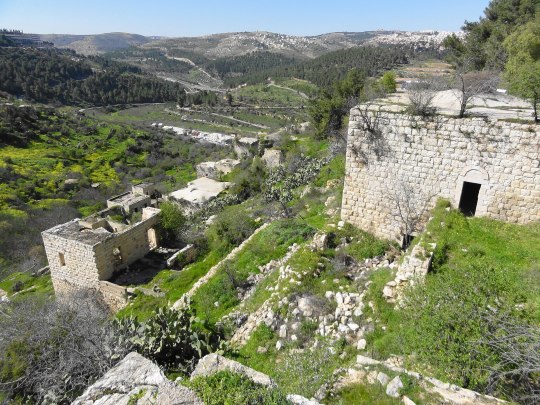



when the homes in the depopulated palestinian village of lifta were originally built is impossible to tell and most likely varies from house to house. the area's been known since ancient times, including having been written about in the hebrew bible. it's retained multiple different names throughout history - lifta by romans, nephto by byzantines, clepsta by crusaders, then lifta again by arabs. in more recent times, the area saw battle in the early 19th century, when it saw a peasant's revolt against egyptian conscription and taxation policies. (egyptian-ottoman ruler muhammad ali had attempted to become independent from the ottoman empire, and sought to use the area of "greater syria" which palestine was apart of as a buffer state.)
the village was predominantly muslim with a mosque, a maqām for local sage shaykh badr, a few shops, a social club, two coffee houses, and an elementary school which opened in 1945. its economy was based in farming - being a village of jerusalem, farmers would sell their produce in the city's markets. an olive press which remains in the village gives evidence to one of the most important crops its residents farmed. the historically wealthy village was known for its intricate embroidery and sewing, particularly of thob ghabani bridal dresses, which attracted buyers from across the levant.
lifta also represents one of the few palestinian villages in which the structures weren't totally or mostly decimated during the 1948 nakba. 60 of the 450 original houses remain intact. from zochrot's entry on lifta:

israel's absentee property law of 1950 permits the state to expropriate land and assets left behind, and denies palestinians the right to return to old homes or to reclaim their property. it's estimated that there's around 400,000 descendants of the village's original refugee population dispersed in east jerusalem, the west bank, jordan, and the palestinian diaspora.
like many depopulated palestinian houses, some of those in lifta were initially used to settle predominantly mizrahi immigrants and refugees, in this case 300 jewish families from yemen and kurdistan. the houses weren't registered in their names, and the area generally saw poor infrastructure and no resources including water and electricity provided by the government. most left in the early 1970s as a part of a compensation program to move out people who'd been settled in depopulated palestinian houses - if they didn't, they were referred to as "squatters" and evicted. (holes were even drilled in the roofs of evacuated buildings to make them less habitable). the 13 families which remain there today only managed to do so because they lived close to the edge of the village.
in 1987, the israeli nature reserves authority planned to restore the "long-abandoned village" and turn it into a natural history center which would "stress the jewish roots of the site", but nothing came of it. several more government proposals on what to do with the land had been brought up since then. this culminated in in 2021 when the israel land administration announced without informing the jerusalem municipal authorities that it issued a tender for the construction of a luxury neighborhood on the village's ruins, consisting of 259 villas, a hotel, and a mall. since 2023, they've agreed to shelve and "rethink" these plans after widespread objection.
the reasons for the objections varied significantly between the opposing israeli politicians - who see the village as an exemplar of cultural heritage and "frozen in time" model of palestinian villages before 1948 - and palestinians - who largely see the village as a witness of the nakba and a symbol of hope for their return. lifta is currently listed by unesco as a potential world heritage site, a designation netanyahu has threatened to remove several times.
many palestinians who are descendent from its former residents still live nearby. like with many other depopulated palestinian villages, they've never ceased to visit, organize tours of the village, and advocate for its preservation.
#palestine#info#nakba#my posts#the dresses link isnt specific to lifta thobs but provides a good overview#i couldn't find anything online abt lifta's embroidery but some of the book pdfs on palestinian costume i reblogged a while ago have info
381 notes
·
View notes
Text
“Many of the women in Heterodoxy moved in corresponding circles and maintained similar beliefs. They were “veterans of social reform efforts,” writes Scutts in Hotbed, and they belonged to “leagues, associations, societies and organizations of all stripes.” A large number were public figures—influential lawyers, journalists, playwrights or physicians, some of whom were the only women in their fields—and often had their names in the papers for the work they were performing. Many members were also involved in a wide variety of women’s rights issues, from promoting the use of birth control to advocating for immigrant mothers.
Heterodoxy met every other Saturday to discuss such issues and see how members might collaborate and cultivate networks of reform. Gatherings were considered a safe space for women to talk, exchange ideas and take action.”
In the early 20th century, New York City’s Greenwich Village earned a reputation as America’s bohemia, a neighborhood where everyone from artists and poets to activists and organizers came to pursue their dreams.
“In the Village, it was so easy to bump into great minds, to go from one restaurant to another, to a meeting house, to work for a meeting or to a gallery,” says Joanna Scutts, author of Hotbed: Bohemian Greenwich Village and the Secret Club That Sparked Modern Feminism. Here was a community where rents were still affordable, creative individuality thrived, urban diversity and radical experiments were the norm, and bohemian dissenters could come and go as they pleased.
Such a neighborhood was the ideal breeding ground for Heterodoxy, a secret society that paved the way for modern feminism. The female debating club’s name referred to the many unorthodox women among its members. These individuals “questioned forms of orthodoxy in culture, in politics, in philosophy—and in sexuality,” noted ThoughtCo. in 2017.
Born as part of the initial wave of modern feminism that emerged during the 19th and early 20th centuries with suffrage at its center, the radical ideologies debated at Heterodoxy gatherings extended well beyond the scope of a women’s right to vote. In fact, Heterodoxy had only one requirement for membership: that a woman “not be orthodox in her opinion.”
“The Heterodoxy club and the work that it did was very much interconnected with what was going on in the neighborhood,” says Andrew Berman, executive director of Village Preservation, a nonprofit dedicated to documenting and preserving the distinct heritage of Greenwich Village. “With the suffrage movement already beginning to crest, women had started considering how they could free themselves from the generations and generations of structures that had been placed upon them.”
Unitarian minister Marie Jenney Howe founded Heterodoxy in 1912, two years after she and her husband, progressive reformer Frederic C. Howe, moved to the Village. “Howe was already in her 40s,” says Scutts, “and just got to know people through her husband’s professional connections, and during meetings and networks where progressive groups were very active at the time.”
Howe’s mindset on feminism was clear: “We intend simply to be ourselves,” she once said, “not just our little female selves, but our whole big human selves.”
Many of the women in Heterodoxy moved in corresponding circles and maintained similar beliefs. They were “veterans of social reform efforts,” writes Scutts in Hotbed, and they belonged to “leagues, associations, societies and organizations of all stripes.” A large number were public figures—influential lawyers, journalists, playwrights or physicians, some of whom were the only women in their fields—and often had their names in the papers for the work they were performing. Many members were also involved in a wide variety of women’s rights issues, from promoting the use of birth control to advocating for immigrant mothers.
Heterodoxy met every other Saturday to discuss such issues and see how members might collaborate and cultivate networks of reform. Gatherings were considered a safe space for women to talk, exchange ideas and take action. Jessica Campbell, a visual artist whose exhibition on Heterodoxy is currently on display at Philadelphia’s Fabric Workshop and Museum, says, “Their meetings were taking place without any kind of recording or public record. It was this privacy that allowed the women to speak freely.”
Scutts adds, “The freedom to disagree was very important to them.”
With 25 charter members, Heterodoxy included individuals of diverse backgrounds, including lesbian and bisexual women, labor radicals and socialites, and artists and nurses. Meetings were often held in the basement of Polly’s, a MacDougal Street hangout established by anarchist Polly Holladay. Here, at what Berman calls a “sort of nexus for progressive, artistic, intellectual and political thought,” the women would gather at wooden tables to discuss issues like fair employment and fair wages, reproductive rights, and the antiwar movement. The meetings often went on for hours, with each typically revolving around a specific subject determined in advance.
Reflecting on these get-togethers later in life, memoirist Mabel Dodge Luhan described them as gatherings of “fine, daring, rather joyous and independent women, … women who did things and did them openly.”
Occasionally, Heterodoxy hosted guest speakers, like modern birth control pioneer Margaret Sanger, who later became president of the International Planned Parenthood Federation, and anarchist Emma Goldman, known for championing everything from free love to the right of labor to organize.
While the topics discussed at each meeting remained confidential, many of Heterodoxy’s members were quite open about their involvement with the club. “Before I’d even heard of Heterodoxy,” says Scutts, “I had been working in the New-York Historical Society, researching for an [exhibition on] how radical politics had influenced a branch of the suffrage movement. That’s when I began noticing many of the same women’s names in overlapping causes. I then realized that they were all associated with this particular club.”
These women included labor lawyer, suffragist, socialist and journalist Crystal Eastman, who in 1920 co-founded the American Civil Liberties Union to defend the rights of all people nationwide, and playwright Susan Glaspell, a key player in the development of modern American theater.
Other notable alumni were feminist icon Charlotte Perkins Gilman, whose 1892 short story, “The Yellow Wallpaper,” illustrates the mental and physical struggles associated with postpartum depression, and feminist psychoanalyst Beatrice M. Hinkle, the first woman physician in the United States to hold a public health position. Lou Rogers, the suffrage cartoonist whose work was used as a basis for the design of Wonder Woman, was a member of Heterodoxy, as was Jewish socialist activist Rose Pastor Stokes.
Grace Nail Johnson, an advocate for civil rights and an influential figure in the Harlem Renaissance, was Heterodoxy’s only Black member. Howe “had personally written to and invited her,” says Scutts, “as sort of a representation of her race. It’s an unusual case, because racial integration was quite uncommon at the time.”
While exceptions did exist, the majority of Heterodoxy’s members were middle class or wealthy, and the bulk of them had obtained undergraduate degrees—still very much a rarity for women in the early 20th century. Some even held graduate degrees in fields like medicine, law and the social sciences. These were women with the leisure time to participate in political causes, says Scutts, and who could afford to take risks, both literally and figuratively. But while political activism and the ability to discuss topics overtly were both part of Heterodoxy’s overall ethos, most of its members were decidedly left-leaning, and almost all were radical in their ideologies. “Even if the meetings promoted an openness to disagree,” says Scutts, “it wasn’t like these were women from across the political spectrum.”
Rather, they were women who inspired and spurred each other on. For example, about one-third of the club’s members were divorced—a process that was still “incredibly difficult, expensive and even scandalous” at the time, says Scutts. The club acted as somewhat of a support network for them, “just by the virtue of having people around you that are saying, ‘I’ve gone through the process. You can, too, and survive.’”
According to Campbell, Heterodoxy’s new inductees were often asked to share a story about their upbringing with the club’s other members. This approach “helped to break down barriers that might otherwise be there due to their ranging political views and professional allegiances,” the artist says.
The Heterodoxy club usually went on hiatus during the summer months, when members relocated to places like Provincetown, Massachusetts, a seasonal outpost for Greenwich Village residents. As the years progressed, meetings eventually moved to Tuesdays, and the club began changing shape, becoming less radical in tandem with the Village’s own shifting energy. Women secured the right to vote with the ratification of the 19th Amendment in 1920, displacing the momentum that fueled the suffrage movement; around this same time, the Red Scare saw the arrests and deportations of unionists and immigrants. Rent prices in the neighborhood also increased dramatically, driving out the Village’s bohemian spirit. As the club’s core members continued aging, Heterodoxy became more about continuing friendships than debating radical ideologies.
“These women were not all young when they started to meet,” says Scutts in the “Lost Ladies of Lit” podcast. “You know, it’s 20, 30 years later, and so they stayed in touch, but they never really found the second generation or third generation to keep it going in a new form.”
By the early 1940s, the biweekly meetings of Heterodoxy were no more. Still, the club’s legacy lives on, even beyond the scope of modern feminism.
“These days, it’s so easy to dehumanize people when you’re only hearing one facet of their belief system,” says Campbell. “But the ability to change your mind and debate freely like the women of Heterodoxy, without any public record? It’s an interesting model for rethinking the way we talk about problems and interact with other people today.”
82 notes
·
View notes
Text









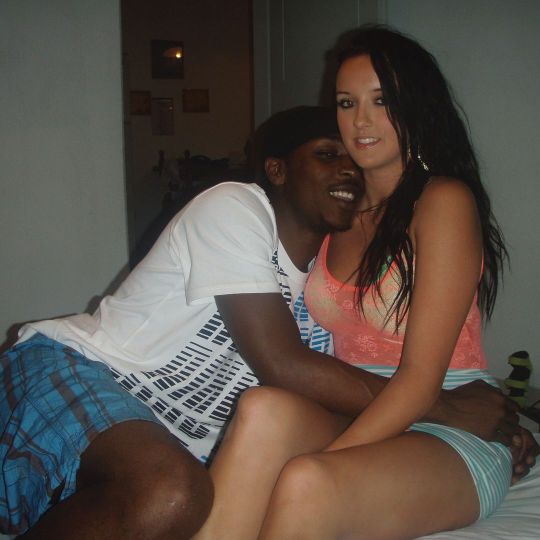
Images that tell a story, we've seen this film many times, a British woman who feels good surrounded by black people, goes to African bars and clubs because she feels good in this environment. She also sympathizes and supports black movements and social actions and organizations that fight for the rights of African immigrants and the black cause, and it is in this context, immersed in black culture that she falls in love with a black man who is everything she ever dreamed of, and When she least expects it, she is already giving birth to black children and is proud of the path she has taken and becomes a symbol of a warrior woman who fights against racism and xenophobia
#british woman#united kingdom#mixed pregnancy#interracial pregnancy#blacklivesmatter#refugees welcome#africanrefugees#africanrefugeeswelcome#mixed babies#mixed family#white mother
65 notes
·
View notes
Text
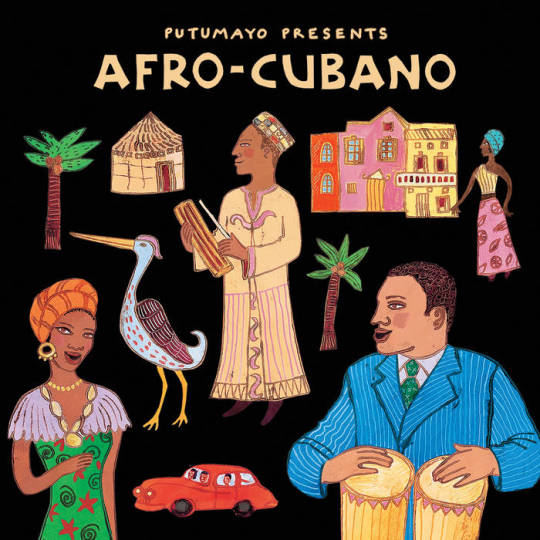
Music of African heritage in Cuba derives from the musical traditions of the many ethnic groups from different parts of West and Central Africa that were brought to Cuba as slaves between the 16th and 19th centuries. Members of some of these groups formed their own ethnic associations or cabildos, in which cultural traditions were conserved, including musical ones. Music of African heritage, along with considerable Iberian (Spanish) musical elements, forms the fulcrum of Cuban music.
Much of this music is associated with traditional African religion – Lucumi, Palo, and others – and preserves the languages formerly used in the African homelands. The music is passed on by oral tradition and is often performed in private gatherings difficult for outsiders to access. Lacking melodic instruments, the music instead features polyrhythmic percussion, voice (call-and-response), and dance. As with other musically renowned New World nations such as the United States, Brazil and Jamaica, Cuban music represents a profound African musical heritage.

Clearly, the origin of African groups in Cuba is due to the island's long history of slavery. Compared to the USA, slavery started in Cuba much earlier and continued for decades afterwards. Cuba was the last country in the Americas to abolish the importation of slaves, and the second last to free the slaves. In 1807 the British Parliament outlawed slavery, and from then on the British Navy acted to intercept Portuguese and Spanish slave ships. By 1860 the trade with Cuba was almost extinguished; the last slave ship to Cuba was in 1873. The abolition of slavery was announced by the Spanish Crown in 1880, and put into effect in 1886. Two years later, Brazil abolished slavery.
Although the exact number of slaves from each African culture will never be known, most came from one of these groups, which are listed in rough order of their cultural impact in Cuba:
The Congolese from the Congo Basin and SW Africa. Many ethnic groups were involved, all called Congos in Cuba. Their religion is called Palo. Probably the most numerous group, with a huge influence on Cuban music.
The Oyó or Yoruba from modern Nigeria, known in Cuba as Lucumí. Their religion is known as Regla de Ocha (roughly, 'the way of the spirits') and its syncretic version is known as Santería. Culturally of great significance.
The Kalabars from the Southeastern part of Nigeria and also in some part of Cameroon, whom were taken from the Bight of Biafra. These sub Igbo and Ijaw groups are known in Cuba as Carabali,and their religious organization as Abakuá. The street name for them in Cuba was Ñáñigos.
The Dahomey, from Benin. They were the Fon, known as Arará in Cuba. The Dahomeys were a powerful group who practised human sacrifice and slavery long before Europeans arrived, and allegedly even more so during the Atlantic slave trade.
Haiti immigrants to Cuba arrived at various times up to the present day. Leaving aside the French, who also came, the Africans from Haiti were a mixture of groups who usually spoke creolized French: and religion was known as vodú.
From part of modern Liberia and Côte d'Ivoire came the Gangá.
Senegambian people (Senegal, the Gambia), but including many brought from Sudan by the Arab slavers, were known by a catch-all word: Mandinga. The famous musical phrase Kikiribu Mandinga! refers to them.
Subsequent organization
The roots of most Afro-Cuban musical forms lie in the cabildos, self-organized social clubs for the African slaves, and separate cabildos for separate cultures. The cabildos were formed mainly from four groups: the Yoruba (the Lucumi in Cuba); the Congolese (Palo in Cuba); Dahomey (the Fon or Arará). Other cultures were undoubtedly present, more even than listed above, but in smaller numbers, and they did not leave such a distinctive presence.
Cabildos preserved African cultural traditions, even after the abolition of slavery in 1886. At the same time, African religions were transmitted from generation to generation throughout Cuba, Haiti, other islands and Brazil. These religions, which had a similar but not identical structure, were known as Lucumi or Regla de Ocha if they derived from the Yoruba, Palo from Central Africa, Vodú from Haiti, and so on. The term Santería was first introduced to account for the way African spirits were joined to Catholic saints, especially by people who were both baptized and initiated, and so were genuine members of both groups. Outsiders picked up the word and have tended to use it somewhat indiscriminately. It has become a kind of catch-all word, rather like salsa in music.
The ñáñigos in Cuba or Carabali in their secret Abakuá societies, were one of the most terrifying groups; even other blacks were afraid of them:
Girl, don't tell me about the ñáñigos! They were bad. The carabali was evil down to his guts. And the ñáñigos from back in the day when I was a chick, weren't like the ones today... they kept their secret, like in Africa.
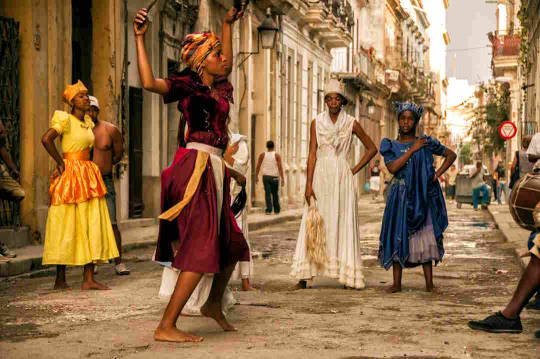
African sacred music in Cuba
All these African cultures had musical traditions, which survive erratically to the present day, not always in detail, but in the general style. The best preserved are the African polytheistic religions, where, in Cuba at least, the instruments, the language, the chants, the dances and their interpretations are quite well preserved. In few or no other American countries are the religious ceremonies conducted in the old language(s) of Africa, as they are at least in Lucumí ceremonies, though of course, back in Africa the language has moved on. What unifies all genuine forms of African music is the unity of polyrhythmic percussion, voice (call-and-response) and dance in well-defined social settings, and the absence of melodic instruments of an Arabic or European kind.
Not until after the Second World War do we find detailed printed descriptions or recordings of African sacred music in Cuba. Inside the cults, music, song, dance and ceremony were (and still are) learnt by heart by means of demonstration, including such ceremonial procedures conducted in an African language. The experiences were private to the initiated, until the work of the ethnologist Fernando Ortíz, who devoted a large part of his life to investigating the influence of African culture in Cuba. The first detailed transcription of percussion, song and chants are to be found in his great works.
There are now many recordings offering a selection of pieces in praise of, or prayers to, the orishas. Much of the ceremonial procedures are still hidden from the eyes of outsiders, though some descriptions in words exist.
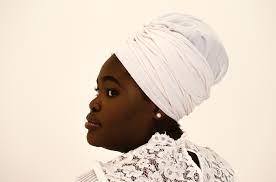
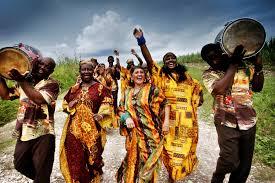
Yoruba and Congolese rituals
Main articles: Yoruba people, Lucumi religion, Kongo people, Palo (religion), and Batá
Religious traditions of African origin have survived in Cuba, and are the basis of ritual music, song and dance quite distinct from the secular music and dance. The religion of Yoruban origin is known as Lucumí or Regla de Ocha; the religion of Congolese origin is known as Palo, as in palos del monte.[11] There are also, in the Oriente region, forms of Haitian ritual together with its own instruments and music.
In Lucumi ceremonies, consecrated batá drums are played at ceremonies, and gourd ensembles called abwe. In the 1950s, a collection of Havana-area batá drummers called Santero helped bring Lucumí styles into mainstream Cuban music, while artists like Mezcla, with the lucumí singer Lázaro Ros, melded the style with other forms, including zouk.
The Congo cabildo uses yuka drums, as well as gallos (a form of song contest), makuta and mani dances. The latter is related to the Brazilian martial dance capoeira

#african#afrakan#kemetic dreams#africans#brownskin#brown skin#afrakans#african culture#fitness#afrakan spirituality#afro cuban music#afro cuban#igbo#yoruba#congo#african music
125 notes
·
View notes
Text
Lore: Life in Faerûn, Part 1
Disclaimer & Other Stuff
[tldr: D&D lore is a giant conflicting mess. Larian's lore is also a conflicting mess. You learn to take what you want and leave the rest]
Abeir-Toril
Why it's called the "Forgotten" Realms
History | Time & Festivals | Lexicon [1] [2]| Languages | Living in Faerûn [1] [?] | Notable Organisations | Magic | Baldurs Gate | Waterdeep | The Underdark | Geography and Human Cultures
---[WIP]
---
Demihumans in common society (ie human society); common is not a daily language; the postal service; some stuff about gender, gender roles and body modification in the Realms; social strata... Plus some details about other things - most of which will be built on in other posts.
Also featuring; what to do with your leisure time in the realms: like literature, theatre, cafés, where to go clubbing aaand the festhalls.
Education: church school, rich idiots at academies, bardic colleges, etc.
And how good medicine is on Toril, if you can't find a spellcaster to heal you. Baths are both mandatory and freely available, we shall have no unwashed peasants in this setting.
-----
Humans are the dominant peoples of the Realms, and the vast majority of cultures one will find oneself in are human cultures. Nine-in-ten people are human, with the one remainder being one of any of the eight non-humans (some of whom are more commonly encountered than others).
Most of what is said here refers to human lands and cultures (which is 99% of the world anyway), and non-human cultures I'll cover in their own write ups.
Humans mostly know the other "common" races - elves, dwarves, halflings and gnomes, whom they call "demihumans" or "humanoids" - as trade partners or as neighbours belonging to minority groups within their home cities.
Demihumans are mostly accepted as fellow citizens within human lands, although the elves are often viewed with mistrust due to the stereotype that they are fickle fey creatures who get uppity when you start tearing down nature and building your cities in their lands. This tolerance is not extended to people who are categorised as monsters, including the Underdark races, tieflings and "goblinkin" - a category that includes orcs, goblins, bugbears and so forth. Half-orcs usually find themselves being sorted into this category, and most have to deal with a lot of respectability politics in order to be accepted into their human family's lands. Elves and dwarves also share this hostility towards orcs, and have a long history of wars with them.
The hin (halflings, to non-hin) and gnomes who find themselves living in human cities are accepted by being seen as useful in the eyes of the Big Folk. Both are known as being useful as couriers, tinkers and repairmen, and for running laundromats. Gnomes in particular are the chief inventors and innovators of the realms, and due to their tendency to be quiet and helpful they are heavily overlooked by others.
Dragonborn are a rare sight, but have mostly built a reputation of respect.
Most humans do not know much about non-human cultures, knowing them only through story, rumour and whatever personal experience they have. Stereotypes are often taken at face value, and being more used to the likes of lightfoot halflings and silver elves, the average person would probably be quite surprised by the different cultural attitudes and colder receptions they'd get from, say, ghostwise halflings or gold elves.
Outside of cosmopolitan areas, where your neighbour can punch you in the face for stupid comments, humans feel no particular pressure to be respectful to demihumans and foreigners, and would roll their eyes at what their Earth equivalents would call "political correctness" if you told them off.
On the nonhumans' end, humans are watched with concern, as they do tend to cause their fair share of disasters that rapidly become everyone's problem.
Many of the people of Faerûn move around a lot; religious pilgrims, traders, immigrants and those bloody adventurers transcend the boundaries of culture and country on a daily basis. For this reason, the Common tongue was invented.
People do not use Common as a daily language, though certain terms may enter daily speech as loanwords. Common is a pidgin trade tongue that grew out of Chondathan, the language spoken in Western Faerûn. It's a simple language, easy to learn and spread around, and useful for exchanging basic information with people from other lands who don't share a language with you - but it's useless for daily life. While it has a written form, most people can't read or write in it.
-
Maps are rare, and if you want an accurate map you'll usually find it in the possession of local rulers and temples (which supply the Realms with most of their scribes and such). Each realm has a book of maps (atlas) available for the use of their military and other officials.
-
If you want to send a package or letter in the Realms, temples often double as a post office. The delivery will be sent from temple to temple until it reaches its destination and will be delivered to the addressee,
-
Most of the Realms does not consider men or women to be inherently lesser or greater than the other and all genders are equal under all laws, though they do have traditional gender roles that it's believed most are better suited for - or at least areas where one gender is more represented than the other. Women dominate in trade and domestic areas, while men dominate in war and crafting, however it isn't considered immoral or unthinkable to see somebody defying the gender norm. If your daughter picks up a sword, learns to use it and runs away to fight dragons your primary concerns are less "oh no, a girl is fighting" and far more likely about the threat to her life and who in the hells is going to help you run the family store now if she has no siblings?
Gender roles can be looser or more rigid, depending on where in the Realms you go. Some realms may be Patriarchal or Matriarchal, but it's not the rule and some of these places have grown more egalitarian over time.
Organisations do not generally discriminate in any way based on gender when it comes to their members.
The term for transgender in the Common tongue is sildur.
(Elven: Alur, Dwarvish: Thulol, Gnome: Thoulal, Hin: Zalshaer)
Transmutation magic is the primary form of body modification and transitioning on Toril, although apparently most people will turn towards divine magic before trusting a wizard to do it. Mages are expensive to hire and viewed with some measure of fear by the common person.
You can petition the gods at their temples for body modifications in return for sufficient offerings, if you don't trust wizards. Be that "I want to be blond" or "I don't want these breasts." Exactly how much and what the god is going to expect in exchange for this varies on the faith of the petitioner and the past relationship between them and the god.
Naturally, certain gods are favoured above others for this kind of thing. You're more likely to petition Sune (love and beauty) or Liira (joy and freedom) than the likes of Bane and Shar.
---
Faerûn has its social classes, defined by wealth and family lineage, but they do not have true feudal or caste systems, or any system where upwards social mobility is totally impossible (though the upper classes will certainly do their best to prevent that. (Hi, Waterdeep, I'll give you your own post)). Any commoner could theoretically gain a noble title to the distress of the hereditary nobility. In Sembia if you have enough coin, you can just give yourself a title and everyone has to shut up and go along with it, because money. And that's how most of them got theirs anyway.
Slavery is illegal in all of Faerûn with the exception of Dambrath, Thay, Mulhorand and Unther. The slave trade still exists underground elsewhere, and is quietly overlooked in some places, but it is considered evil by the world at large and somebody found to be a slaver will be met with violent reprisal.
Nobles are... well, nobles. They're rich and have powerful friends and the law is far nicer to them than to the lower classes. They're mostly corrupt and constantly scheming against each other. Their kids go through rebellious stages and do drugs and cause chaos for the commoners and join weird cults.
Landownership outside of kingdoms and such with codified property law generally follows the rules that you can do what you like with whatever land you hold; charge rent, put up signs, make the rules... but you own it only by the tolerance of your neighbours. If they don't like the way you do things, you're quickly going to find yourself in trouble. Also led to my one of my new favourite quotes:
“If you set up an inn and then murder everyone who stops there
and keep their goods, even if that’s morally acceptable to you as a devout follower of Bane or of Cyric, it will not be suffered to stand."
Yes! Screw you, edgelord!
Crime and punishment varies depending on where you are, but carries fun stuff like fines, brandings, prison labour, floggings, stockades and executions.
I think the concept of the law, "justice" and court proceedings will be left for another post where I will passive aggressively judge a young Astarion and his corrupt magistrate ways.
-
Leisure:
Literature:
Literacy is a hit and a miss in the Realms. Some people prize literacy, and it's common enough that broadsheets and newspapers are in business and PCs can read and write by default; but there are still others who can't and couldn't care less if they can't read some bard's chicken scratch. The ruling class in particular gets a little nervous about the idea of a fully literate populace, since that would allow them to be educated, and better suited to communicate with each other and get ideas.
That bit varies though. Cormyr, for example. has encouraged its population to learn to read and get educated for several reasons including making it harder for the country to be infiltrated by enemy spies.
Chapbooks are serially published cheap little paperback things. They contain all sorts of things, like children's tales, donated recipes, political opinions, random bits of advice from people on trades and such, gossip from other countries disguised as news, memoirs, and smut.
The rating of that last bit varies in rating. In Waterdeep they favour romantic stories over sex and over in Amn they're just flat out publishing porn about the goddesses of love and sensuality, Sune and Sharess - with the full support and encouragement of their churches.
The most popular genre of actual novels is the personal travel logs of explorers and other wanderers. The Realms are flooded with such books.
There are also non-fiction books available. Philosophy (which is written through the lens of religion, as a rule); books on rulership (controlled by the noble class, sometimes outlawed); and on business (which are subject to attempted control by the likes of merchant guilds)
Book printing is a sketchy business. Authors may one day discover that there are whole new best selling reprints of their books they've never been informed of (or paid for). Plagiarism is also a common problem.
Theatre:
Aside from actual theatres, there are a few ways to catch a play.
Traveling caravans are known to sport a few actors, who can make a bit of extra money for the group by putting on a performance as well as advertising the stock their caravan carries (product placement everywhere). Most bards have the "classic" scenes of famous plays memories, so as to perform them on demand.
Theatres often hire doppelgangers, as their shapeshifting ability is very useful in realistically portraying monstrous characters too dangerous to actually hire. Of course there's also this little issue where your doppelganger hirelings may start killing people outside of work hours, but eh. The show must go on.
There are also puppet shows like Punch-and-Judy called Oldboots - because the shows are actually done by wearing worn old boots on your hands instead of actual puppets.
Establishments:
Alehouses - Pubs and bars, existing primarily for those looking for an alcoholic beverage. The term "barkeeper" is unknown to Torilians, who would refer to them as tavernmasters. The word "mug" and "pint" also do not exist.
Inns and Alehouses don't have menus, you're eating whatever's being cooked.
Dining-house or Feasthall - Known to us as a restaurant. Establishments are also known by the Chondathan word skaethar which is used as a formal term in Common in other parts of the world. In larger inns, one might find a section of the building that acts as a dining-house.
Most of the time the menu is a chalk board on the wall, informing customers what's fresh.
The really fancy ones, visited by the rich (or those who want to seem so) get paper menus printed by machine or made with fancy calligraphy.
Kaeth house - A café.
Coffee is known in the Realms as kaeth or kaethae - or "fireswill", colloquially. The drink is rare and expensive northwards of Calimshan, but is available in large cosmopolitan trade cities, as far North as Waterdeep.
Calishite coffee is taken black with nuts and spices like ginger. Sembian and Chessentan styles of coffee are often mixed with chocolate and liqueur. In lands where coffee is widely known, they tend to have their own drinking utensils and customs around it, but in the north it's just served in tankards.
Hot chocolate is also on the menu.
Teas exist, but are less popular and are seen as a medicinal drinks.
Temples of Liira - The goddess of joy and revelry charges her followers with hosting parties and making everyone they meet is having fun and feeling happy. As such, going to her temples is kind of like going clubbing. The main hall of the temple is a dance hall, with other rooms branching off to include lounges and a well-stocked bar. Liirans also offer dance lessons.
Temples of Sune - As devotees of the goddess of beauty, Sunites are obligated to give you a makeover if you ask, so this is a good destination for a haircut, pedicure or fashion consultation or whatever. As Sune is also the goddess of love, Sunites can also be asked for matchmaking services. The church also sponsors schools and classes teaching all forms of art (including music, song, performance arts, etc).
Festhalls - Try not to confuse these with feasthalls, or you're going to have an embarrassing time.
Ah Festhalls, where to start. They're spaces considered outside of society; everyone leaves their real life, identity, social rank and all of that outside and comes here to just let go for a few hours.
Festhalls will provide you with a warm bed for the night; they'll wash, mend and dry your clothes; they have hot baths and spa services; you can dance to music, or just lounge around enjoying a good drink and some company; it's also something of a casino, where you can play cards and gamble or even just play normal board games or something...
And they're strip clubs, BDSM scenes and specialty brothels! You got a kink none of the brothels can scratch? Festhalls provide and cater to goddamn anything that turns you on, so long as it's legal, safe, sane and consensual.
---
Education:
What counts as an education varies from place to place and depends on what the realm desires of its public. Some places will emphasise the commoners knowing the basics of military drills, the chain of command and such in case of the need for a levy. Other places, like trade centres such as Waterdeep, prioritise maths and literacy.
In most of the Realms - especially in rural areas, a basic informal tutoring involves teaching basic maths, local laws and customs and some basic knowledge of the alphabet and market/road signs.
Most schooling is done by priests, which is free to the public. Unless you're dealing with the sketchier gods or the ones with deeper mysteries, all clergy are also happy to teach everything about their faith when asked. While some may obscure less savoury details, no follower of any god will outright lie about the details of their faith, as that is considered a sin.
If you're not rich you can get a basic education by hiring "low sages" - the likes of book shop owners, hedge mages, retired adventurers and other people with access to information who can share with you what they know. Of course, what they know may not be the most accurate information in the world.
You can also purchase some basic short paperback school books.
Most trades guilds will provide a basic education in that trade in exchange for a coin or two. Although some of this will simply just be "don't do this at home, hire a professional." They also hold classes open to the public now and then.
Schools as educational organisations also exist and are usually founded by bards or monastic orders in large cities. Most schools and academies are simply a handful of ageing, well educated people with a house who provide lessons for enrolled children there - though larger establishments exist.
For nobles there are Academies, which will also teach their children social etiquette and other things the upper class needs to worry over lest their reputation drop so low it falls into the Lower Planes and dies in the River Styx.
Sometimes these Academies are actually just social clubs for young rich idiots to get drunk, do drugs and have orgies in, but that's not so common and gets shut down when it does happen.
While the rich and powerful have the opportunity to send their darlings to Academies, they'd rather not. It's... embarrassing. It means you can't afford a private tutor (or that your darling is a brat with a personality that suggests they're a demon spawned in the Abyss).
Bards are usually trained at Bardic Colleges - these vary in quality and specialty (some may be better for certain instruments, for example).
The only requirements for entry are that one passes an audition, impressing their interviewers enough that they are taken on.
Civic information is typically freely available to anyone who asks for it, and courtiers and scribes are obligated to share the information.
---
Medicine:
Medicine is primarily the practice of demihumans, who've been around for much longer than humans and had more practice. They also tend to hold the market, finding a place for themselves in human lands by offering their services as physicians and herbalists.
Faerûnians have an almost Earth-level awareness of human anatomy; the organs and their function, the function of blood and the cardiovascular system as well as the risks of shock and infections are common knowledge. While the concept of microbes and spread of disease is unknown, the importance of hygiene in staying healthy is known, and there are establishments that offer baths and laundry services to travellers and homeless people. The filthy unwashed peasant is not a thing on Toril.
Plagues are not as disastrous as they were in Earth history - most households and communities will avoid being totally wiped out, but they are terrible and mysterious things and the afflicted are avoided.
Medicines as we know them - called "physics" - are expensive and hard to get ahold of, and most people rely on herb lore or priests like clerics and druids. Herbal anaesthetics are widely used. Cauterisation is a common practice, and many people have scars from it.
Most trade towns have apothecaries, be they part of a shrine or a business.
Physicians are often in conflict with divine spellcasters, since they're competing over the same market.
Some diseases are known by different names in the Realms:
Windchill fever - Pneumonia
Sallar - Typhus
Whitewasting - Leprosy
Foamjaws - Rabies
And a heart attack is known as a heartstop.
110 notes
·
View notes
Text
Random Headcanons from Random Characters in 'The Girl in IT' Pt. 2 - Sugar

Who is our Joel without his Sugar? Meet the girl behind 'The Girl in IT'! Read Joel's Headcanons here!
Sugar had a very privileged, yet lonely childhood. Her father was a workaholic and her mother was a too-busy socialite, so Sugar only had her grandmother who immigrated to the States at the insistence of her daughter. Sugar's grandmother was her entire world, and when she passed when she was in high school, the last thing her grandmother asked her was if she had a boyfriend yet, which gave her a weird complex. This happened to me with my own grandmother and her passing, and it very much gave me a complex.
That being said, Sugar really did not have an intended set of features when I thought her up. She is you, she is me, she is all of us! (if you want).
If Sugar wasn't in IT, she would definitely be in film. Sugar loves films, and is determined to watch the movies she loves with Joel.
Sugar is very socially awkward and challenged! She has a close group of friends but normally keeps to herself. She hates going to bars, or clubs and only went on dating apps at the insistence of her friends. She hated it.
Sugar once shared with Joel how she has never felt like she had a home, always feeling like a stranger in someone else's house when she was growing up. She wasn't allowed to run through the house or invite anyone over, and it affected her greatly. This prompted Joel to ask her what her dream home would be, and well...
Besides Joel, Ellie is her favorite person. Ellie was the first person to visit her office when she started at Miller Construction group, asking her about her taste in music. If there is something that Sugar loves more than film, it's music. Ellie normally hangs around Sugar's office if she's not out on the field with Tommy.
Sir Bubbles is her grandmother's cat.
She dances when she feels strong positive emotions - when she is happy, excited, or in love. Joel loves this about her and will take any chance to grab her and slow dance.
She is also a sci-fi nerd and loves that one actor who plays The Mandalorian... wink wink. "Don't you think you look a lot like him, Joel?" she teases.
#The Girl in IT#Sugar's Headcanon#pedro pascal#joel miller fanfiction#joel miller x reader#joel miller#joel miller x you#pedro pascal fanfiction#joel miller x female reader#joel tlou#joel the last of us
68 notes
·
View notes
Photo

“Eloquent Witness Merely Stuttering,” Toronto Star. October 19, 1932. Page 1.
----
Court Didn’t Know Until Told by Interpreter
---
Montreal, Oct. 19 - Hum Lee stood in the witness box, shrugged his shoulders and burst forth in a crackling, sputtering torrent of Chinese. Court and spectators marvelled at his nimble tongue and versatile vocal chords.
Admiration at last gave way to impatience at the length of the story Hum Lee, doorkeeper of the Sai Lee Amusement Club, told of how the club was robbed by seven compatriots. Judge Lacroix asked the interpreter why it took so long to tell a simple story.
‘The witness stutters, my lord,’ explained the interpreter.
The trial of the seven accused of stealing $100 from the club will continue.
#montreal#doorman#social club#robbery#eyewitness testimony#armed robbery#chinese canadians#chinese immigration to canada#great depression in canada#crime and punishment in canada#history of crime and punishment in canada
1 note
·
View note
Text
KJ Charles has breathtaking range. And it's all so organically diverse and vivid and excellently paced and clever.
Doomsday books -- Smugglers of Romney Marsh in 1810–20s in the wake of the Napoleonic Wars.
Society of Gentlemen -- Clash between the royalist establishment and radical republicans in the last years of Regency.
Sins of the Cities -- Small businesses and trade of the Industrial Revolution in London's immigrant quarter (taxidermy of all things!), Victorian spiritualists and musical hall artists in the 1870s.
Lillywhite Boys -- London criminal underworld, bluestocking feminists, private detectives, colonial gem trade, the rise of industrialists in the 1890s, and pre-Victorian folk Christmas traditions.
Charm of Magpies -- Shanghai traders and Chinese immigrant communities of London in the late 1800s.
England World -- Nascent British intelligence agencies and new technology in the shadow of the Boer War in the 1890s + integration of Indian nobles from its last kingdoms with elite British society + classism and xenophobia in British antisemitism
Will Darling Adventures -- The reverberating social, political and economic changes from the aftermath of WWI and further development of intelligence organisations during the 1920s.
Just finished Band Sinister, which touched on Hellfire Clubs, the emergence of new medicine, atheism, and challenge Creationism from the fields of natural science, and Black British life before abolition. Currently reading Unfit to Print, which seems to be about London's underground pornography trade with character focus on the shared plight of Black and Indian immigrants from the colonies and their mixed race offspring. Charles's body of work really brings home that the 19th century was a full hundred years long and the distinct character of every decade. And that the real and authentic history of Britain had people of every race, religion, colour, disability, neurodiversity, gender and sexuality who have been deliberately erased by the same power structures that kept them disenfranchised and ghettoed back then.
#british history#british culture#black britain#british immigrants#british colonialism#historical fiction#queer history#queer historical fiction#queer historical romance#mlm romance#kj charles#book recs#book recommendations#knee of huss
24 notes
·
View notes
Text
chie aoki (she) character & art by @animevillainscourge
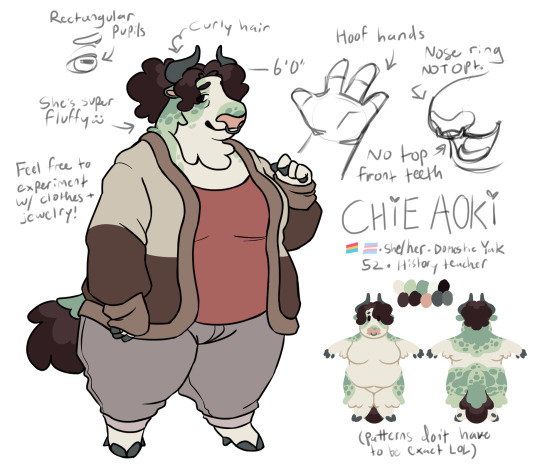
Chie is a 52 year old domestic yak with two dog husbands and three kids. She is a high school history teacher and enjoys reading and writing horror in her free time, as well as photography and baking. She is very caring and emotionally in tune with others, but her fear of hurting people has created an unhealthy habit of letting others walk all over her. She struggles in social situations, but she is still quite extroverted and spends as much time as possible with her husbands, children and friends. She is also a big fan of hugs!
VS.
naomi (she) character & art by @ackee

naomi chung, one of the main characters of my future webcomic, traversion. she's a chinese-jamaican immigrant who moved to miami in her mid 20s to pursue her dream of becoming a tattoo artist. outside of work, she spends her time hitting up alternative and caribbean clubs around town with her best friend and roomate, xia. loves to use men for free drinks. a huge bitch with even bigger boobs.
neocities page
47 notes
·
View notes
Text
WIP WEDS
From 'Henry Fox, All-American Hero', since I'm holding back stuff for Cold Cases, Lost Causes.
“What’s your name?” asks the woman, her dark hair tied back in a no-nonsense ponytail.
“Er, Henry. Henry Fox,” he finds himself saying, his voice feeling thin and higher than normal.
“You an immigrant, Henry?” asks the guy.
“Graduate student. Um, at Georgetown. I’m studying History.”
“How did you and your friend meet? Any socials? Clubs?”
For a split second, Henry has no idea who they’re talking about, and his brain offers up Pez. He’s about to say that they met at school, and then, thankfully, his brain resets and he realises with horrifying clarity that they’re talking about the shooter.
“I don’t know him!” Henry exclaims. “I was just walking past - and then he had a letter - but it wasn’t a letter, it was a gun, and the president - so I pushed him - oh my god, is the president hurt?!”
Spoiler: everything is fine
...tagging @everwitch-magiks @dumbpeachjuice @clottedcreamfudge @cha-melodius @celaestis1 @cricketnationrise @welcometololaland @rmd-writes and if I've forgotten you, I'm sorry!
40 notes
·
View notes
Text
Had an opposite day idea that I'm kind of taken with but need to think of a plot for: rich!Trapper/poor!Charles.
Like, I love the working class Trapper HC, it's my bread and butter background for him, but it's just that- a v popular HC, it's not actually canon.
So like, Trapper in this verse is new money- his great-grandad was an immigrant, his grandad owned a successful business, and his dad was a doctor who wants Trapper to continue growing the family legacy. They're not wildly extravagantly wealthy, but they're affluent, belong to the country club, he went to the same posh boy's school as Charles and was expected to get into an Ivy League school which he did. He's not a prick about it, but he's used to being comfortable, having nice clothes and good food, he has expensive hobbies like golf and high stakes poker, he spoils his girls, etc.
Charles family was old money Boston Brahmin descendents of the Mayflower etc. but they lost most of their money and investment income in the 1929 crash, when Charles was 10 or 11. They managed to hold on to the family estate, and like maybe his maternal grandparents still had money to help with his schooling or something, but everything else is desperately keeping up appearances and living beyond their means, hoping their financial situation is just a "temporary embarrassment". Which is part of why Charles is such a prick about it- he's faking it till he makes it, hoping to help keep up appearances until he's successful enough in his career he can restore the Winchester family to its former glory. Oh no you can't possibly meet him at his club, it's far too exclusive (he can't afford initiation/membership dues) etc. Pretending hes a legacy admission when he's actually a scholarship boy, etc.
IDK, maybe a childhood friends scenario where they meet in high school and Trapper finds out Charles Terrible Secret TM and is chill about it, or Charles starts being buddy buddy to get him to keep quiet about it but they actually grow closer, them keeping up a friendly rivalry through college and med school, or Charles using Trapper's connections to fake a social status he doesn't quite have and Trapper helps him because he likes mischief and finds Charles schemes more funny/endearing than annoying because he's known him since they were kids... Hrm.
20 notes
·
View notes
Text
Cobra Kai 2.0
Something that struck me about the new Cobra Kai versus the Cobra Kai in the films -
Nearly every Cobra Kai member they focus on in the series is underprivileged. Hawk is disabled. Miguel is a poor boy whose family are immigrants. Tory is a fatherless poor caretaker of a sick mother and younger brother. Kenny is a poor black kid picked on by a bunch of rich white kids. Yes, there's Parker, but did he ever get his own episode? Aisha is a bullied black kid, though she's rich (which got her booted off the show).
The Miyagi Do's are the rich ones, the stable ones (no one we know of among them, other than Robby, has much hardship to overcome). Beautiful dojo and everything.
But that wasn't what the films were selling! The Cobra Kais were a group of mostly white preppy rich kids ganging up on one new poor kid, who, to some people in that Encino club, might still have counted as not-quite-white (if Aly was born around 1966, her parents will have been born around 1930-1940, and to those people, Daniel LaRusso would have been called a swarthy wop, guinea or dago by some people they grew up with, if they're too polite to use such language by 1983). Daniel definitely takes pains not to seem other to his environment even in 2018.
Sorry, but if your message is: "Cobra Kais are people too", why can't you simply try to win sympathy for preppy white kids? Why make Johnny into a blue collar worker? Nothing in his background suggests that. Why not make him a divorced, washed up, bankrupted investment banker? Why have Eli not simply be the vaguely Jewish kid who has trouble making friends? Really, if your whole raison d'être is "shitty rich kids are people too", why are you making it so that your protagonists are always fighting the rich kids? Who... aren't even shitty? Who did Samantha LaRusso ever hurt? And maybe there's Anthony, but he's barely in the show for three seasons.
Teaching poor kids to fight dirty because life can do you dirty is borderline justified. But The Karate Kid was about rich kids being taught to fight dirty and then taking all their advantages out on poor kids, because might makes right. Johnny, with his bike, and his preppy clothes, laughing at Daniel who has to sneak in through the kitchen to see his uptown girl. Chozen, the strong henchman to his insanely rich uncle, ganging up on the poor foreign boy. Terry Silver, making business deals with career fighter Mike Barnes. Humanise that all you like - but we also see what that looks like in the films, and that's Aly. The rich girl who really likes this new sweet kid, and doesn't care his mother is probably too outspoken for her parents' liking, and doesn't care her girlfriends don't much care for him. Aly, who is nothing but polite to Mr. Miyagi (compare that to Terry Silver's openly racist taunts), and only breaks up with Daniel when he jumps to conclusions (once about the class difference, another time when he was openly jealous about her talking to other guys). Show why, as taught by Johny, Cobra Kai 2.0 is good for those kids, or indeed show Johnny figuring out why it isn't and trying to make a change.
Because a poor kid learning "No Mercy" because they're trying to survive in a world that is trying to crush them is a very different setup than teaching a rich kid with all advantages in the world how to go around and pick on people, which is what Kreese was doing. The closest we get to that in the show is Hawk. It indeed isn't pretty and his redemption is entirely rushed, but even Eli, vaguely Jewish kid with a scarred face and trouble understanding social cues, had it much harder than, say, Tommy, who simply liked to win fights with his friends, if that meant nearly beating a young Newark boy to death after a school dance.
12 notes
·
View notes
Text
What "Hia" means to Win, and to Team
So, after @ellaspore posted her really insightful thoughts on the significance of Team calling Win Hia, I went down many rabbit holes trying to find a way to articulate how I feel about this too. A big thank you to the wonderfully sweet @lutawolf and @ellaspore and the rest of the #coconutsmafia gang for giving me the confidence to post this!
Hia and Phi are both honorifics and kinship terms - a concept many speakers of Indo-European, Austroasiatic or Sino-Tibetan languages will understand. They bear similarities with terms such as the Chinese Ge, the Japanese Aniki, Senpai, and the Korean Hyung, Sunbae etc. But each of these terms carry slightly different cultural connotations - like the difference between saying This is my father vs This is my old man - it says something about you as the speaker, and about your father as the addressee, who allows (or at least does not dispute) your chosen form of address. So, beyond simply according respect to the addressee, what does it actually mean, culturally, when we use these terms? Specifically, what does Hia mean to Win, the Thai-Chinese vice president of the varsity swim club, and what does it mean to Team, his Thai junior and freshman on a swimming scholarship?
Or, a really long rambling about social hierarchy, power asymmetry and social groups, and why I think Team's "Hia!" is just so damn adorable.
I would like to address some Thai cultural norms - if you are a lover of Thai BL you'll probably be familiar with some of these already (skip to the next indented paragraph) but I think it's best to establish my knowledge base before we move on. These are all very brief summaries of complex topics as understood by someone whose context is derived largely from academic and grey literature, so I welcome any further discussions on the topic! I have included links where possible, but apologize that not everything is open source.
The Basis of Social Hierarchy in Thai Culture
Generally speaking, there are two ways in which one can achieve a higher status within the Thai social hierarchy - through achieving the Buddhist concept of Merit, and through the more conventionally understood concept of Power. The latter takes many forms - rich/poor, employer/employee, caregiver/dependent, teacher/student, senior/junior, more experienced/less experienced etc. Now, I understand many people balk at the idea that age or seniority automatically bestows power upon a person, but this idea is based upon the (not always true) assumption that age correlates to being wiser or more experienced, and is an extremely ingrained concept in many Asian cultures.
Power Asymmetry ≠ Abuse of Power
It is important that we get this straight - being respectful to someone higher in the social hierarchy than you does NOT mean you are giving them a right to abuse you. The relationship between the superior and the subordinate is bidirectional - there is a mutual dependency between both parties. More on this below.
The Assimilation of Thai-Chinese in Thailand
Chinese traders began immigrating to Thailand as early as the 1600s, and Sino-Thai trade had been established long before that. Most of these traders belonged to the dialect groups of Cantonese, Hainanese, Hakka, Hokkien, or Teochew, with the latter eventually rising to be the largest group amongst the Chinese in Thailand. They often took up entrepreneurial jobs and started businesses. Due in large part to political efforts occurring around the late 18th century, the Thai-Chinese are an extremely well-integrated ethnic group, and most Thai-Chinese these days speak only Thai, identify as Thai and do not have a strong connection to their Chinese heritage. That said, many words of Chinese origin can be found in the Thai language - Hia, for eg, originates from the Teochew word Hian (兄) for older brother.
(Skip to here!) Now with that out of the way, let's dive into the actual point of this post.
"Hia is more intimate than Phi"
This was the most common explanation I found when trying to figure out the difference between Hia and Phi. But what does "more intimate" actually mean? Intimate in what way? As a partner (as in the Korean oppa) or as family (similar to the use of Ge - older brother - in Chinese) or marking someone as part of the inner circle/social group (a concept shared across Kor/Chi/Jpn)? Is it all? It's often described as a term used for those of Chinese descent - but that also means technically anyone could call Win Hia and it would still be socially acceptable (as seen from how people call some small business owners this too, since a large majority are of Chi descent). Also, as mentioned earlier the Thai-Chinese have assimilated very well, which means it's unlikely that the term is used just as a way to mark a person's heritage. There must be something else that makes Hia special to Win, and, to Team.
Kinship Terms of Address
There were a number of comments I found that alluded to Phi being less special than Hia because you could, in general, use it for anyone older than you. To examine this claim, we need to backtrack a bit and compare Phi/Nong relationships to just purely formal acquaintance (Khun/Khun) - Is there a difference? Yes. The use of familial kinship terms of address when referring to non-family members specifically acknowledges the power imbalance in the social hierarchy - and it's a little more than just being polite. Broadly speaking invoking these terms initiates a two-way relationship - the younger gives respect and obedience and the older provides care and guidance. The common metaphor used is that the elder should be "a large tree in the shade of which the [younger] can rest and be content". That said, the steepness of this power imbalance varies - grandparent's generation vs parent's generation (including non-related "uncles/aunts") vs older sibling's generation (the one we are interested in), in descending order of steepness. There were 2 papers I found relevant to this topic - one examining the use of these terms and hierarchy in children's playgroups and another at the university level.
My conclusion is that Phi/Nong corresponds more generally to the Japanese idea of Senpai/Kouhai - the Japanese rarely use kinship terms to refer to unrelated people, although Aniki is an exception (Interestingly enough, Aniki can be used to refer to gang leaders, as apparently, Hia can too). When someone calls you Senpai, you're socially obligated to do a few things: look after them, guide them, treat them to food etc. In other words, it creates a relationship between 2 individuals and marks them as members of a particular social group. Yet, you don't go around Japan calling people Senpai if you have no connection to them and just want to catch their attention in a less formal, but still polite way - which you could do with Phi, when trying to for eg, order food from a street vendor. That usage is more akin to how Ge is used in Chinese. But again, going around calling everyone Ge is not as common as the use of Phi appears to be in Thailand. So, Phi/Nong is different from formal acquaintance in that it identifies 2 people as part of an in-group of sorts, and depending on the context, there are different societal expectations of either party.
What Hia Means to Win and Team
If we follow this line of thought, then Hia is a subset of the Phi/Nong relationship and also identifies Win and Team as being a part of a certain in-group. But which in-group is it? The "significant other" group or the "familial" group? There is a distinction because the hierarchy in the former is slightly more flattened and flexible than that in the latter. If we consider that Hia indicates Chinese heritage and thus identifies a particular in-group within the overarching "Phi/Nong in-group", then it follows that Win must invite Team into this particular in-group - Team can't just join it as he pleases. Thus, to Win, Hia means not only his desire to care for Team, but also to claim Team as a member of his in-group. Family is very important to Win, even though (or maybe especially because) he feels overlooked within his own. In 7-11 he lists all the terms Team can call him by - daddy, husband, wifey - these are all familial terms. He doesn't offer up boyfriend. Hia is Win's invitation to Team to be part of his family. And yet, there's an additional layer to this particular relationship because Win extends this invitation to Team just before they become intimate (and this is why I believe it was never a one-night stand from Win's POV). This moves this particular in-group beyond just the hierarchical and familial connotations of kinship terms and creates a group in which only Win and Team can claim membership. Ie, it combines the steeper hierarchy of "familial connection" with the more flexible hierarchy of "significant other". To Win, allowing Team to call him Hia marks Team as someone special and under his "umbrella" or "tree branches", if we follow the metaphor above (this ties into the possessiveness discussion @lutawolf shared previously), and Team's acceptance implies his agreement to accept the care and guidance Win wants to provide.
And Team does get this, on some level. He gets that Win sees him as someone different, though I think he is not quite ready to admit that Win sees him as "special". He gets that Win cares for him - but again he's unsure about whether or not Win wants to care for him (as opposed to fulfilling his duties as Team's senior/Phi), because at this point I believe Team doesn't quite understand the full significance of Win inviting him to call him Hia. Having said that, subconsciously or not, Team leans into Win's care - he drops Hia in nearly every sentence like it's a comma (which, as I understand from @lutawolf, is something subs do subconsciously too). It's one of the reasons why I think Team is so fantastically adorable tbh - you certainly don't need to use Hia so often in speech - but Team uses it all the time and most often as a form of entreaty - a request for affection, leniency, and care, as is his right as Win's junior, in exchange for respect and obedience. To be honest, in terms of being respectful and obedient, it may sometimes seem like Team doesn't fulfill his end of the bargain - but he does when it counts. When he says thank you sincerely, after Win helps him sleep, when he listens to Win's instructions, and when he lets Win take the lead in their interactions.
Team whines, but is NOT whiny (I will fight you on this!)
The way Team uses Hia relates to the Japanese concept of amae, the Chinese concept of sajiao, and somewhat but not quite to the Korean concept of aegyo, and I believe to the Thai concept of ngon. Again, these concepts are all slightly different, but suffice to say it is a behavior that the younger, or subordinate, in the relationship sometimes displays. It is often translated as "to act cute, as a child" or "to act affectionately", "in a manner that endears oneself to the receiver". To the uninitiated, it can be seen as being childish, manipulative even, and just downright strange that grown adults would do this - but it is a way of recognizing the receiver's power by appealing to their benevolence and generosity. It softens a demand for something into a request and smooths over many potentially conflict-inducing interactions (such as apologizing in an argument). Often times, it is a subconscious behavior that is naturally brought forth by the power asymmetry in a relationship. So Team whines yes, but he isn't whiny. On the contrary, it's super endearing - and the Chinese translation of Hia as Gege (typically the way young children call their older brother - usually changes to Ge as they get older) is driving half the Chinese fandom nuts because it's just too damn cute when Team does it.
In conclusion, Win's invitation to Team to call him Hia is a representation of his desire to care for Team and to guide him, and most importantly, a recognition that Team is a member of his in-group. He likes it when Team calls him Hia, because by doing so, Team acknowledges this relationship and even asks for Win's care and affection. And to Team, Hia means, at least subconsciously, care, affection, acceptance, and protection - though I feel he's not fully ready to accept that it also means that he is Win's, and is special. Hia Win means more to Team than he realizes currently, and that's why he has difficulty answering A's question.
#between us#between us the series#winteam#coconuts mafia#sociolinguistics#this got really long sorry#i'm not good at being succint#all this to say i really love winteam's dynamic#yes i tend to get a bit obsessive over things i like#and the lengths i will go in order to fangirl is kinda ridiculous#this was a great way to procrastinate tho#and it's been stuck in my head all this while#what else could i do#ok but now i'm really not free#dammit
150 notes
·
View notes